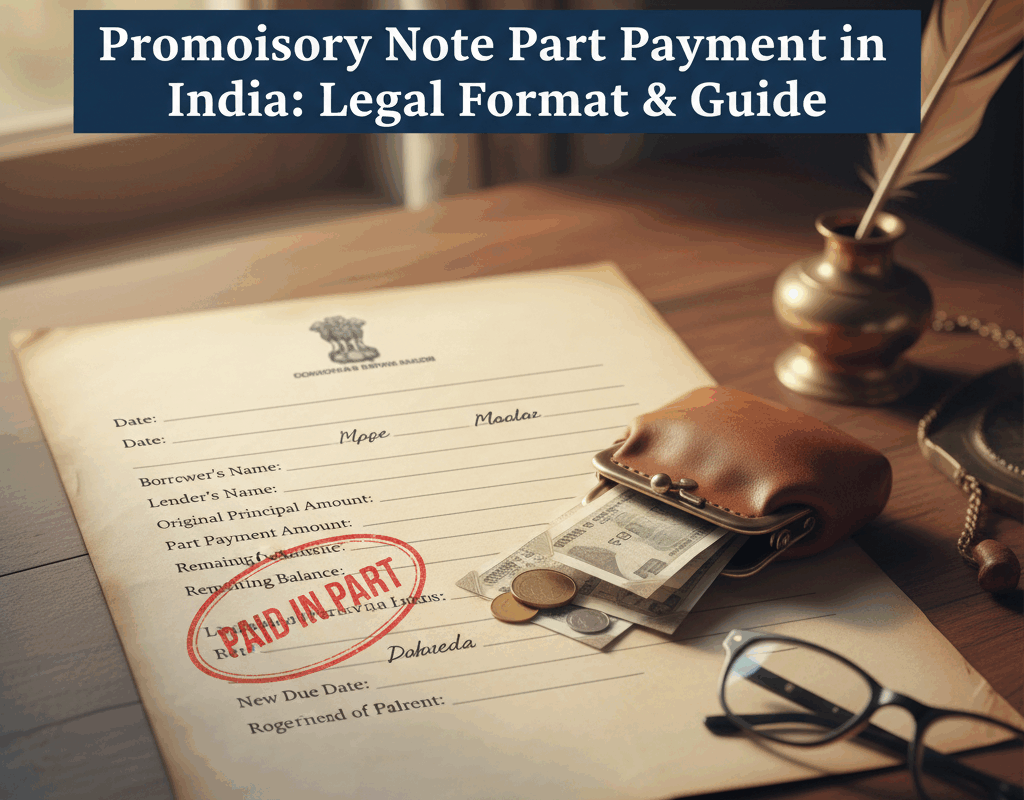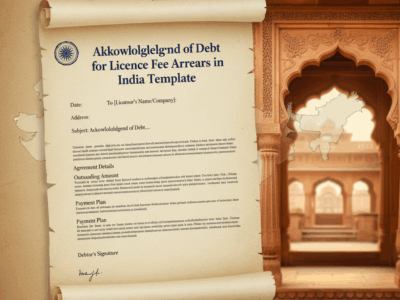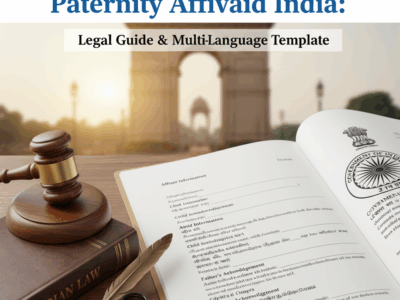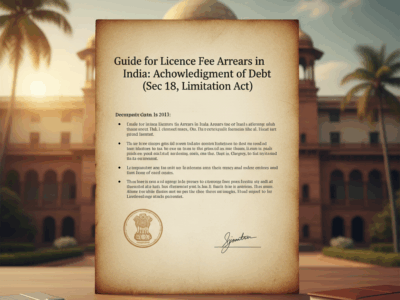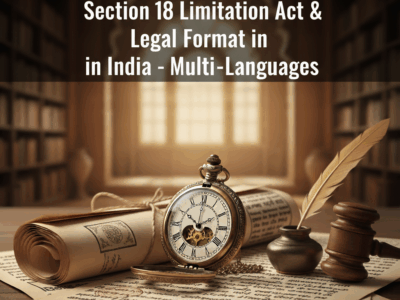Navigating the acknowledgment of part payment on a promissory note is a critical legal step for both creditors and debtors in India. A properly executed endorsement not only serves as a record of payment but, more importantly, resets the clock under the Limitation Act, 1963, preserving the right to legal recovery.
This comprehensive guide breaks down the essential laws, including the Negotiable Instruments Act, 1881, and the Indian Stamp Act, 1899. We will explore the strategic implications, common pitfalls like the Section 138 cheque dishonour trap, and provide actionable checklists. Learn how to draft a legally sound acknowledgment with our multi-language formats to protect your financial interests.
A Legal Guide to Acknowledging Part Payments on Promissory Notes in India
Updated: October 2025
Executive Summary
This guide dissects the "Acknowledgment by Endorsement on the Promissory Note" under Indian law. Its core function is twofold: to formally record a partial payment, and more critically, to reset the statutory limitation period for debt recovery. This analysis navigates the Negotiable Instruments Act, 1881, the Limitation Act, 1963, and the Indian Stamp Act, 1899, offering strategic insights for both creditors and debtors.
Section 1: The Promissory Note: Foundation of the Debt
Before analyzing the acknowledgment of a part payment, it's essential to understand the underlying instrument: the promissory note. Its validity is the bedrock upon which all subsequent actions rest.
1.1 Core Components of a Valid Promissory Note
Under Section 4 of the Negotiable Instruments Act, 1881, a promissory note is more than just an "I.O.U." It must contain several key elements to be legally enforceable.
In Writing
A verbal promise is not enough. The undertaking must be written.
Unconditional Promise
The promise to pay must be absolute, not dependent on any condition.
Signed by Maker
The person making the promise (debtor) must sign the instrument.
Certain Sum of Money
The amount to be paid must be definite and clearly stated.
Certain Parties
The maker (debtor) and payee (creditor) must be clearly identifiable.
Crucially: Must Be Stamped
An unstamped promissory note is inadmissible as evidence in court under the Indian Stamp Act, 1899.
Section 2: The Two Types of "Endorsements"
The term "endorsement" can be confusing. On a promissory note, it refers to two distinct legal acts with very different outcomes.
| Feature | Endorsement for Negotiation | Acknowledgment of Part Payment |
|---|---|---|
| Primary Purpose | Transfer ownership and rights to a new holder. | Record a payment and acknowledge the remaining debt. |
| Who Signs? | The holder/payee (Creditor). | The maker (Debtor). |
| Legal Effect | A new person becomes the legal holder of the note. | Resets the 3-year limitation period for legal recovery. |
| Governing Law | S. 15, Negotiable Instruments Act | S. 56, NI Act & S. 18, Limitation Act |
Section 3: The Critical Role of Stamping & Witnesses
While the promissory note itself requires stamping, it is a common and critical error to overlook the stamping requirement for the part-payment acknowledgment. This small detail can render the acknowledgment useless in court.
3.1 Stamping the Acknowledgment
Under the Indian Stamp Act, 1899, any acknowledgment of a debt used to supply evidence in court must be stamped. For a part-payment endorsement, this typically means affixing a Re. 1 revenue stamp.
Consequence of Non-Stamping: An unstamped or improperly stamped acknowledgment will be considered inadmissible as evidence by a court, meaning it cannot be used to prove the extension of the limitation period.
Procedure: The revenue stamp should be affixed to the promissory note (usually on the reverse side where the acknowledgment is written), and the debtor must sign across the stamp and onto the paper.
3.2 The Evidentiary Value of a Witness
While not legally mandatory for a valid acknowledgment, having the debtor's signature witnessed is a highly recommended best practice, especially for creditors.
- Corroboration: A witness can testify in court to confirm that they saw the debtor sign the acknowledgment, adding a strong layer of evidence.
- Deters Disputes: The presence of a witness signature can deter the debtor from later falsely claiming the signature was forged or made under duress.
Section 4: Reviving the Creditor's Right to Sue
4.2 Interactive Timeline: How Acknowledgment Resets the Clock
A creditor has three years to sue for recovery from the date a promissory note is due. A valid written acknowledgment of part payment resets this clock, starting a fresh three-year period.
4.3 The Four Pillars of a Valid Acknowledgment
For an acknowledgment to successfully reset the limitation period under Section 18, it must satisfy four fundamental conditions:
1. In Writing
An oral acknowledgment is legally insufficient.
2. Signed by Debtor
Must be signed by the party liable or their authorized agent.
3. Before Expiry
Must be made before the original 3-year period ends.
4. Admits Liability
Must clearly admit an existing debtor-creditor relationship.
Section 5: Strategic Use Cases & Legal Ramifications
The act of acknowledging a part payment has distinct strategic implications for both parties, extending beyond the mere recording of a transaction.
For the Creditor: A Shield Against Time
The primary use is to prevent a debt from becoming time-barred. Diligently obtaining a signed acknowledgment for every part payment allows for flexible repayment schedules without the risk of losing the legal right to sue for the outstanding amount. It's a powerful tool for managing long-term credit.
For the Debtor: A Record of Repayment
Signing an acknowledgment provides conclusive evidence that a payment was made and accepted. This protects the debtor from any future claim for the full original amount and ensures all payments are properly accounted for, preventing disputes over the remaining balance.
5.3 The Cheque Dishonour Trap (Sec 138, NI Act)
A critical legal issue arises when a creditor holds a post-dated cheque for the full loan amount but accepts a part payment before presenting it.
Flowchart: Part Payment's Impact on Cheque Dishonour Cases
Section 6: Insights from Indian Courts (Case Law Precedents)
The principles governing acknowledgments are not just statutory; they have been shaped and clarified by numerous judgments from the High Courts and the Supreme Court of India. Understanding these judicial precedents is key to applying the law correctly.
1. Strict Interpretation of "Acknowledgment"
Courts consistently hold that an acknowledgment under Section 18 of the Limitation Act must be a clear and unambiguous admission of the existing debt. Vague statements, letters of negotiation, or unaccepted offers of settlement are generally not considered valid acknowledgments.
2. The S.138 Defence (Dashrathbhai Trikambhai Patel v. Hitesh Mahendrabhai Patel)
The Supreme Court has solidified the principle that if a part-payment has been made, the original cheque no longer represents a legally enforceable debt for its full amount. Presenting it will invalidate a subsequent Section 138 complaint. This precedent is a crucial shield for debtors.
3. Burden of Proof Lies on the Creditor
In case of a dispute, the burden to prove that a valid, signed, and timely acknowledgment was made rests squarely on the creditor who is seeking the benefit of the extended limitation period. This is why procedural correctness (stamping, witness) is so important.
4. Acknowledgment Need Not Specify Exact Amount
Interestingly, while the acknowledgment must admit liability, courts have held that it does not necessarily need to specify the exact remaining balance. The admission of the underlying debtor-creditor relationship is often sufficient, with the actual amount being a matter of evidence.
Section 7: Actionable Checklists
Checklist for Creditors (Payees)
- Verify the Foundation: Ensure the original pronote is valid and properly stamped.
- Insist on Acknowledgment: For every part payment, insist on a written, signed acknowledgment.
- Affix Revenue Stamp: The acknowledgment itself must be stamped (e.g., Re. 1 revenue stamp) and signed across by the debtor. This is non-negotiable for court admissibility.
- Get it Witnessed: While not mandatory, a witness signature greatly strengthens your case against future denials.
- Manage Cheques: Never present an old cheque after part payment. Get a new one for the balance.
Checklist for Debtors (Makers)
- Demand Acknowledgment: Never make a part payment without getting a formal acknowledgment from the creditor.
- Verify Details: Before signing, ensure the amount, date, and reference to the correct pronote are accurate.
- Confirm Remaining Balance: Insist that the acknowledgment includes the agreed-upon remaining balance to prevent future disputes.
- Retain Proof: Keep a clear photocopy of the endorsed pronote or a separate signed receipt for your records.
- Retrieve Old Cheques: If you issued a cheque for the full amount, demand its return upon making a part payment.
Section 8: Prescribed Legal Format for Acknowledgment
While the exact wording can vary, a legally sound acknowledgment should be clear, concise, and contain all necessary elements. Below are standard, usable formats that can be written on the reverse side of the promissory note.
ACKNOWLEDGMENT BY ENDORSEMENT ON THE PROMISSORY NOTE
This [Enter Day, e.g., 14th] day of [Enter Month and Year, e.g., October, 2025], I have paid Rs. [Amount in Figures]/- (Rupees [Amount in Words]) in part payment of the within mentioned pronote debt.
(Signed) _________________
Name: [Debtor's Full Name]
Address: [Debtor's Full Address]
Witness:
(Signed) _________________
Name: [Witness's Full Name]
Address: [Witness's Full Address]
Instructions for Use:
- Location: This text should be handwritten or typed on the back of the original promissory note.
- Stamp: A Re. 1 revenue stamp must be affixed on the document before the debtor signs.
- Signature: The debtor must sign across the revenue stamp, so part of the signature is on the stamp and part is on the paper.
- Witness: The witness should sign in the designated area after seeing the debtor sign the document.

